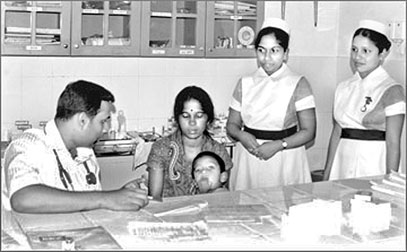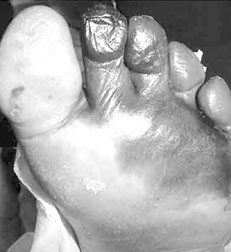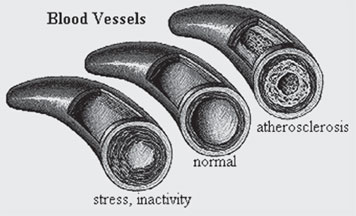|

Good health culture will pave the way for a disciplined society
By Nilma DOLE
Passing the Cotta Road railway junction, motorists immediately catch
sight of the refurbished Borella Dispensary that actually looks like a
private hospital. Most can’t believe that it is in fact a government
dispensary and actually feel like going and using the healthcare
services.
 |
|
Dr. Amal Harsha de
Silva |
Speaking to the Sunday Observer was Dr. Amal Harsha de Silva,
Provincial Director of Health Services, Western Province and founder
Secretary of the Private Health Services Regulatory Council. “A good
refurbishment policy is important to set the standard of discipline in
our society.”
It is evident to see that the refurbishment plays a major role in
making a lasting impression not only on the patient but on their family
members and loved ones who come with them.
“At every base hospital in Sri Lanka, we have about 1200 to 1500
people walking through the doors everyday because patients always come
with a family member or their loved ones when they channel a doctor.
Hence, it is imperative to create a good hospital culture.”
He said that people come to hospitals because they have to and they
are always burdened by problems and mental anguish. “So it’s important
to make them feel right at home when it comes to solving their medical
problems and ailments,” he said.
With a reasonably large health budget and healthcare being at the
foremost of the government’s interest, health is indeed our wealth.
“It is under the supervision of MP Basil Rajapaksa that we have
ensured that a facelift for a majority of hospitals, clinics and
dispensaries will be done promptly. Moreover, we will use the Western
province health institutions to set an example for the rest of our
Provinces to follow,” said the doctor. In addition, he said that already
100 new clinics will be set up and 78 will undergo refurbishment in the
Gampaha district and long-term solutions in a short-term period is the
priority.
In the health guide policy plan initiated will enlist the services of
qualified building contractors and expert landscaped artistes. “In fact
just like the Borella dispensary at Cotta Road, we are fully confident
that we can finish the development of these health institutions can be
done in a year,” said the doctor.
The first aspect would be maintaining strict hygiene and good
practices in health quality. “We will first uplift the standards of the
washrooms and clean them every three hours. Our aim is to create a
quality culture whereby people will automatically be disciplined,” said
the doctor.
The next stage is a nature-friendly environment with a strong
emphasis on green belts to be setup as soon as the health institution is
finished. “We will grow fruit trees that are of high-grade quality,
protect it with fencing and landscape it around the hospitals to offer a
peaceful and tranquil setting,” he said.
By making green environs, garbage disposal and waste management will
be done accordance to standards and garbage bins will be set up and
people will then feel like keeping it clean. The ultimate aim of the
green belt system is to ensure that patients will also be inspired to
grow a fruit tree at home. “In fact, bio-gas facilities have already
been set up at the Homagama and Panadura Base Hospitals and the gas
generated from these facilities helps save Rs. 60,000 every month as
opposed using commercial gas,” said Dr. de Silva.
In fact, the flooding problems occurring at the Panadura Hospital
will be solved when later this year, it will be converted and
refurbished into a 9-storey fully-equipped building.
 |
|
Doctor checking on a
patient at Awissawella Base Hospital |
Moreover, the Avissawella Base Hospital is already an example since
it’s like a five-star hospital.
“The Avissawella Base Hospital is such a good hospital that it is
affiliated to the Inha University in South Korea as a sister hospital
where mutual exchange of knowledge and ideas takes place between the
respective staff,” said the doctor.
This reveals that already Sri Lankan government hospitals are on par
with international standards but only the question of discipline is the
ultimate goal.
“The only way we can be proud of our hospital services is when we are
happy to admit a foreigner to one.
In order to be happy, an ethical standard and good discipline should
take precedence over just the medical cures,” said Dr. de Silva.
Training the health staff is also a national issue and this has to be
dealt with too.
“We have 200,000 health staff working around the country to see that
our health industry is propelled but we need better training to ensure
that they are better educated in dealing with patients’ problems.
For example, we started by changing the dietary menu pertaining to
diabetic patients, health patients and other patients who needed special
vitamins in their diet for healing quickly,” he said. Furthermore, the
doctor said that a patient should be happy when they leave the hospital
after they have been cured.
“We want to instill values in our staff so that we have good feedback
instead of complaint so it’s vital to train our staff on a frequent
basis when it comes to patient satisfaction.” Dr. de Silva was also
mindful of converting maternal health clinics into family clinics.
“Maternity clinics have become a sort of cliche because fathers don’t go
and they are sometimes chased away by our staff.
Hence we are giving training to our staff and changing the mindset of
the fathers of newborns so that they also can be a part of the
experience which is memorable.”
In international countries there is even three months paternity leave
so why can’t a father be close to his baby especially during the
delivery process? He said: "We are planning to introduce a colour-coded
scheme where people can easily find the relevant medical departments for
their benefit and maps to track it.
Implementing an organised system will be a formidable task but we are
confident that it will pave the way for a disciplined society."
Speaking about donations to the hospital, the doctor said: "There are
always happy patients leaving the hospital and so there are bound to be
donations from any patients. But even when it comes to giving donations,
we have to advice the public too."
For example, those who didn’t have much money used to give plastic
buckets and chairs but the doctor said that they don’t have to spend it
on that.
“We are trying to solve the plastic problem but another plastic chair
or a bucket will add to our problems. So we would like an interlocking
tile to modernise the hospital at a cost of Rs.50 per tile,” said the
doctor.
Even people from the middle class or upper-class can ask the hospital
authorities what kind of refurbishment or development is taking place
and obtain advice instead of deciding for themselves what would be good
for the hospital.
“Until today most doctors’ lounges and lunchrooms have been developed
and fully-equipped with flat-screen televisions and canteens but when it
comes to donations, sustainable things should be given,” he said. For
example, the special hospital chairs that can’t be removed or tampered
with, last for 15 to 20 years instead of the plastic chairs that are
easily breakable, removable and contribute to the plastic problem.
So it’s vital in getting the right advice before venturing to buy
things which the hospital doesn’t really require in the long-term. From
the cradle to the grave, we need discipline.
Since a hospital is where we start our life to the time when it ends,
it is vital to develop hospital etiquette in order to develop society.
Exercising caution when you have diabetes
by Karen Schroeder Kassel
Image for diabetes and exercise If you have diabetes, exercise can
help keep blood sugar under control and promote good health. But, there
are precautions you should know about. While exercise is beneficial
because it can lower your blood sugar level, it can also be dangerous
for the same reason. Exercise can lead to hypoglycemia - a quick drop in
blood sugar.
Living with type 1 diabetes requires a balance of eating, exercising,
and insulin usage to keep blood sugar levels within a desirable range.
People without diabetes rarely give blood sugar a thought.
This is because the pancreas automatically produces insulin to escort
sugar out of the bloodstream and into body cells for use. Insulin
production is naturally matched with the amount of sugar in the blood to
keep levels stable.
 |
|
A diabetic's foot |
But, with type 1 diabetes your body does not produce insulin. So you
must take over as the regulator of blood sugar. This is an important
job, as both high and low blood sugar levels can have serious health
consequences.
In type 2 diabetes, your body produces insulin, but your body either
cannot use it properly or does not make enough.
People who manage type 2 diabetes with meal planning and exercise
usually do not have problems with hypoglycemia. But if you use insulin
injections, you may be at risk for exercise-induced hypoglycemia.
Hypoglycemia
During exercise, your muscles take up sugar from the bloodstream to
convert into energy. This can decrease blood sugar to dangerously low
levels (eg, below 70 mg/dL [3.9 mmol/L] depending on the meter and your
doctor’s guidelines). Hypoglycemia can occur quickly. Symptoms include
shakiness, dizziness, sweating, headache, hunger, pale skin, sudden
moodiness, clumsy movements, confusion, and tingling around the mouth.
Severe hypoglycemia can result in unconsciousness or seizures.
But do not let the risk of hypoglycemia keep you from the many
benefits of exercise. With a few precautions, you can re-establish the
balance of food, exercise, and insulin. The American Diabetes
Association (ADA) and the Joslin Diabetes Center recommend these
guidelines for safely incorporating exercise into your lifestyle: Talk
to Your Healthcare Team
Your healthcare team can personalize your exercise goals. Depending
on factors like how long you have had diabetes, your age, and other
health problems, your doctor may do an exam and testing to find out the
type of exercise that is safe for you.
Discuss with your doctor when the best time for you to exercise is.
Monitor your blood sugar closely
Check your blood sugar before, during, and after exercise, and record
these numbers. You and your doctor can use these readings to determine
any changes in your insulin dose. With regular exercise, your need for
insulin may decrease.
Before exercise, check your blood sugar twice: 30 minutes before and
a few minutes before.
This way, you will see if your blood sugar is decreasing. If it is
dropping or it is 100 mg/dL (5.6 mmol/L) or less, have a small snack and
wait for blood sugar to return to normal.
People with type 2 diabetes may be advised to avoid extra snacking
because it may interfere with weight loss (ask your doctor).
If your blood sugar is high-250 mg/dL (13.9 mmol/L) or more-do not
exercise.
Instead, check your urine for ketones. Do not exercise until both
blood sugar and ketone levels return to normal.
During exercise, check every 30 minutes. If blood sugar levels drop
too much (ask your doctor what level is too low), stop exercising and
have a snack. Also, be aware of high levels. Ask your doctor when to
check for ketones and how best to manage high blood sugar.
After exercise, check again. If your exercise session is long, check
regularly for several hours after, as blood sugar may continue to drop.
Be prepared
Always have blood testing equipment, insulin, and high carbohydrate
snacks with you. Good snacks include juice, soft drinks, glucose tablets
or gel, or hard candy. If hypoglycemia is a recurring problem, ask your
doctor about a glucagon injection kit to treat a severe case.
Carry a water bottle and drink often.
Manage complications
To protect your feet, check for blisters or other changes after every
workout. Buy footwear appropriate for the sport and that fit well to
your feet. Wear clean, smooth-fitting socks (made with synthetic
fibres).
Get moving!
There are many benefits to exercise, like reduced stress, decreased
risk of diabetes-related complications, and overall better health. These
benefits far outweigh the inconvenience of the precautions. So, find an
activity you enjoy and get moving!
Courtesy: AHealthyMe
Blood pressure and exercise
UT Southwestern Medical Centre researchers have identified one reason
people with hypertension experience an even greater increase in their
blood pressure when they exercise, and they’ve learned how to prevent
the rise.
A study in a March issue of the Journal of Physiology reported that
hypertensive people who exercise undergo decreased blood flow and oxygen
in muscles. The scientists also identified a specific type of blood
pressure medication that minimizes this effect.
 “While there are many hypertension medications effective at lowering
blood pressure at rest, very few are effective during exercise,” said
Dr. Wanpen Vongpatanasin, associate professor of internal medicine at UT
Southwestern and lead author of the study. “People with high blood
pressure need to exercise not only to help their blood pressure, but
also their overall cardiovascular health.” “While there are many hypertension medications effective at lowering
blood pressure at rest, very few are effective during exercise,” said
Dr. Wanpen Vongpatanasin, associate professor of internal medicine at UT
Southwestern and lead author of the study. “People with high blood
pressure need to exercise not only to help their blood pressure, but
also their overall cardiovascular health.”
Dr. Vongpatanasin said that some people with high blood pressure stop
exercising out of fear of heart attack or stroke, and that sometimes
physicians counsel those patients to limit activity because of those
concerns.While it’s been known that blood pressure increases during
exercise in people with hypertension, a mechanism behind the action and
a way to block it in humans hadn’t been identified previously.
Dr. Vongpatanasin and colleagues had 13 participants with mild
hypertension and 13 with normal blood pressure perform hand grip
exercises under regular conditions, followed by activity under
conditions that affect a part of the nervous system that controls blood
pressure.
They found increased nerve activity in hypertensive participants
during exercise but not in those with normal blood pressure. Blood flow
and oxygen levels in the arm muscles also fell more rapidly in the
hypertensive group.
“In normal people, the body can increase blood flow to the working
muscle despite increase in nerve activity, which tends to cause blood
vessels to constrict,” Dr. Vongpatanasin said.
“Hypertensive patients have increased nerves and impaired ability to
maintain muscle blood flow adequately.”Researchers then treated study
participants with two types of blood pressure medications. An
angiotensin receptor blocker, which prevents the hormone angiotensin
from increasing blood pressure, increased blood flow during exercise.
A diuretic that reduces blood pressure by stimulating sodium loss did
not.“Since nerve increases weren’t reduced during treatment, we believe
the angiotensin receptor blocker works directly on blood vessels to
improve blood flow,” Dr. Vongpatanasin said. The next step, she said,
will be to see if other hormones associated with angiotensin are
involved in similar responses. Sources: UT Southwestern Medical Center,
AlphaGalileo Foundation
Understanding tuft cells’ function in the intestine
The intestinal epithelium consists of four main specialized cell
lineages: absorptive enterocytes and three secretory cell types known as
enteroendocrine, Paneth, and goblet cells. But a rare, fifth type of
intestinal cell called tuft cells also exists.
Defined by the thick brush of long microvilli that project from their
apical surface, tuft cells are seen in several epithelial tissues, yet
little is known about their function due to a lack of tuft cell-specific
markers.
In a recent issue of The Journal of Cell Biology, a team of French
researchers led by Philippe Jay identified a unique “signature” of
proteins expressed by tuft cells. Like other intestinal cell types, tuft
cells turned over rapidly and were replaced by the differentiation of
proliferative stem cells’ progeny in the intestinal crypts.
This differentiation was blocked in the absence of ATOH1 - a
transcription factor required for the development of all intestinal
secretory lineages. Yet tuft cell differentiation didn’t require other
transcription factors that specify enteroendocrine, Paneth, and goblet
cells, suggesting that tuft cells represent a distinct lineage of
intestinal secretory cells.
The team found that tuft cells secrete opioids and produce enzymes
that synthesize prostaglandins. The latter observation suggests that
tuft cells may promote inflammation and tumorigenesis. Indeed, the
researchers identified tuft cell-like cells in several early stage
intestinal tumours.
To really understand tuft cells’ function, however, Jay hopes to
identify transcription factors uniquely required for their development
in order to generate mice that specifically lack tuft cells from their
intestinal epithelium.
Source: University Press
|

